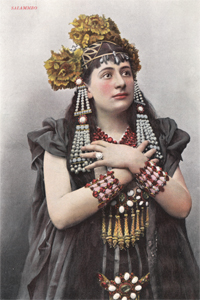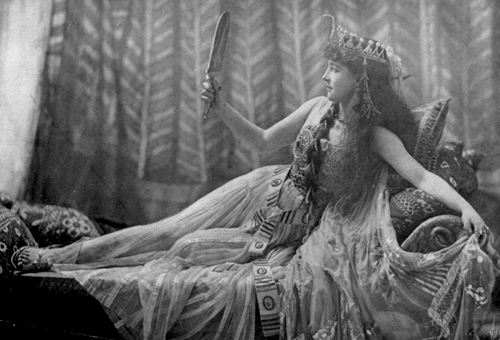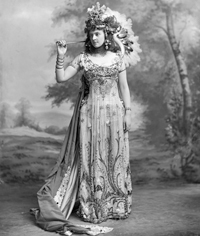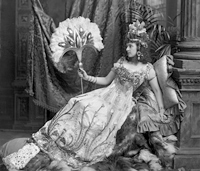Hon Mrs Algernon Bourke,
Hon Mrs Algernon Bourke née Guendoline Irene Emily Sloane-Stanley in 1887 married Hon Algernon Henry Bourke, 3rd son of 6th Earl of Mayo (Viceroy of India) and the owner of White’s – a debonair gentleman’s club in St. James’s, London. Two years before this portrait she and her husband had been gently caricatured in print as the two main characters of Oscar Wilde’s The Importance of Being Earnest. The 1863 novel by Flaubert, Salammbô, about the daughter of a Carthaginian general in the period of the Punic Wars, which inspired a flurry of paintings and sculptures, included a scene where in a semi-trance she sheds her clothing and dances with a python. Mrs Bourke’s snake bangle is most probably a reference to this scene which had long been considered shocking. In the late 1860s the Countess de Castiglione had only been allowed in to a ball at the Tuileries as the improper Salammbô (dressed by Worth of Paris) due to her position as Napoleon III’s mistress. Two days after the Ball Mrs Bourke went to the Bond Street studio to be photographed in a variety of poses and against different backdrops. Her magnificent costume, made by Mrs Mason of New Burlington Street, London, was a gown of white and silver gauze, embroidered with lotus flowers. The top of the gown was appliqué with old green satin embroidered in blue, turquoise and gold and studded with rubies. In both portraits, Mrs Bourke holds a lotus-shaped flabellum inset with ostrich feathers – an item more obviously Egyptian than Carthaginian.
The costume is a fantasy elaboration on the outfit worn by the Belgium soprano, Rose Caron (1857-1930) and later by the Swiss singer Lucienne Bréval when it was enhanced with massive stage jewels. Caron created the title role in Ernest de Reyer’s opera Salammbô which was produced with the great barbaric splendour, so loved at the time, in 1890 at the Théâtre de la Monnaie in Brussels even though her acting was termed “semaphoric”. In the louche reclining pose, an orientalist vision of powerful availability, Mrs Bourke borrows heavily from the femme fatale studies of British actresses of the 1890s such as Lillie Langtry, whose portrait as Cleopatra “reclining on couch & holding mirror” in a state of pert and upright vampishness had sold many a photographic postcard. Mrs Bourke must have been satisfied with her personification as she wore the costume again for a ‘grand tableau vivant and musical burlesque’ at Blenheim Palace in January the following year.
|
Click on image to enlarge Click on image to enlarge
|
||||||
|



 V&A Lafayette Archive
V&A Lafayette Archive V&A Lafayette Archive
V&A Lafayette Archive V&A Lafayette Archive
V&A Lafayette Archive